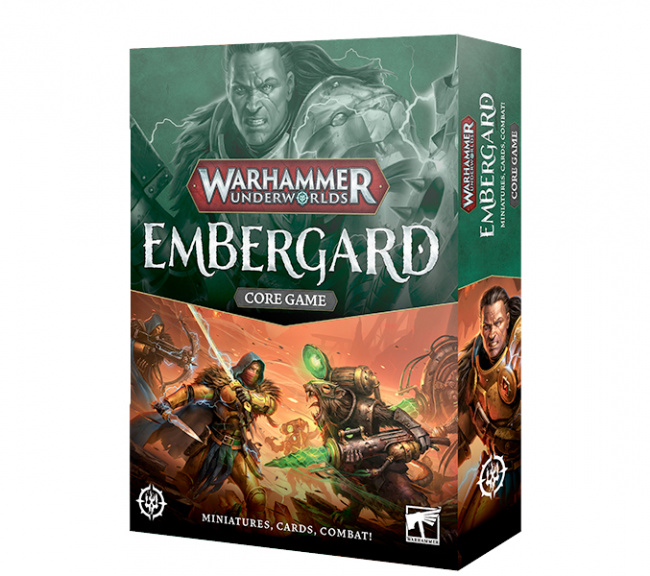The first full edition change of Warhammer Underworlds has arrived, heralded by the Embergard Core Game. As befitting a major edition change of any Games Workshop game, many things have changed while enough have stayed constant that the game is easily recognizable as still being Underworlds. Goonhammer has a series of articles today to walk through the majority of the changes and take an in depth look at the content of Embergard.
This is our landing page for coverage of the new edition, as well as an overview of the contents of the box itself and the rules changes therein. This will serve as a quick onboarding guide to anyone who has been familiar with the state of the game in the last year or so and just wants an update on how the game is going to be changing from last month to now. If you’re returning to the game after being away for a longer period of time (2+ years), or if you are brand new to the Underworlds game, stay tuned – there will be an update to the first Starting Hex article “What is Warhammer Underworlds?” that will hit on all the unique aspects of this cool game and serve as a great starting point.
Our Warhammer Underworlds: Embergard coverage:
- Embergard Core Rules & Unboxing (this article)
- Embergard Deck Reviews Part 1 – Blazing Assault & Emberstone Sentinels
- Embergard Deck Reviews Part 2 – Pillage and Plunder & Countdown to Cataclysm
- Warhammer Underworlds: Embergard Warbands Review – The Emberwatch & Zikkit’s Tunnelpack
The Big, Obvious Stuff
Some of the changes are pretty clear just from looking at the box contents. I’d say the three top highlights here are the board, the warbands’ fighter cards and warscrolls, and the Rivals decks.
Chairman of the Board
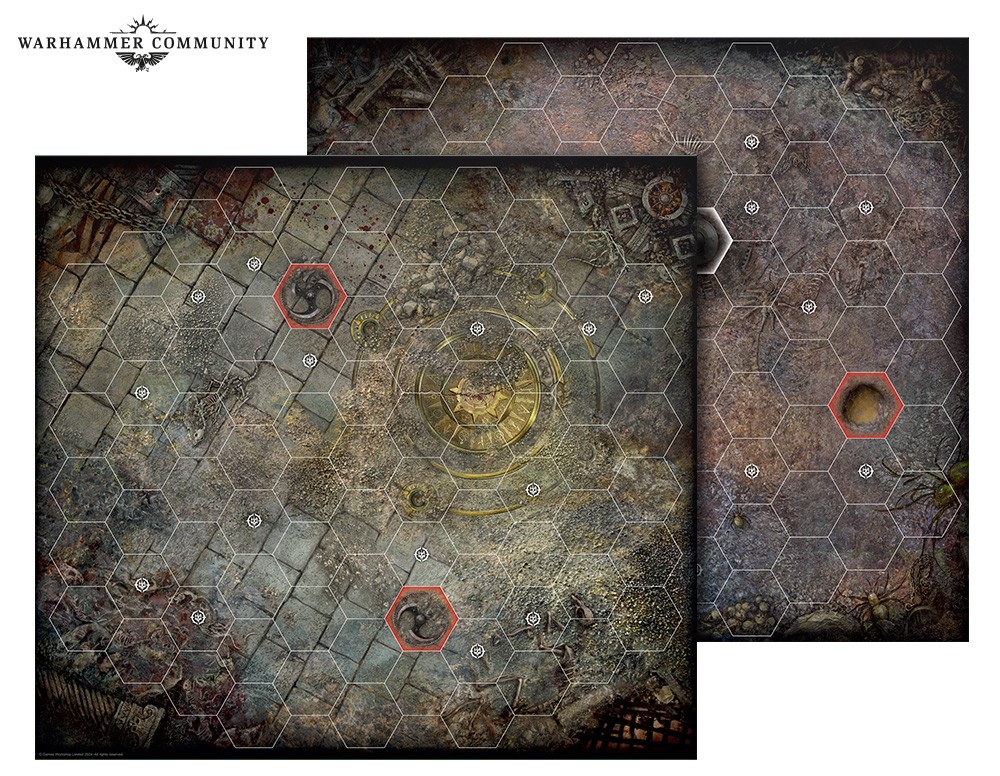
Let’s start off by taking a look at the board. Yes, singular board. One of the most original aspects of the previous edition of Warhammer Underworlds was how each player would select and place a board, creating the playing arena for a game. It was another fairly deep layer of strategy that experienced players could use to flex their system mastery. The downside is if you didn’t know what you were doing, you could severely hamper yourself in the upcoming game before even placing your first fighter. There were a few other issues I personally had like transporting all the boards to events, remembering which ones I wanted to use in which match-ups, and the unfortunate situation of sitting down across from someone at an event only for them to pull out boards which have rotated out of legality.
It seems like someone at Games Workshop had similar feelings, because the playing area is now a single board. The pre-game hurdles before getting to the actual game have been reduced, and I’m currently of the opinion that this is an overall positive change, despite it changing one of the unique aspects the game had previously. The board itself has a smaller footprint than two of the older boards put together – the play area of the old ones would measure 16.5” x 21.5” (long-edge to long-edge) or the perpetually awkward 10.75” x 33” (short–edge to short-edge) compared to the new board’s dimensions of 16.5” x 18”. Games Workshop performed this space saving miracle through the advanced technology of… shrinking the hexes. It doesn’t particularly matter while playing the game, but the fact that there’s now a consistently sized play area and it is slightly smaller is a nice touch for any event organizers planning out seating and also so players don’t have to juggle their setup when someone decides to go for the long board configuration. I never did feel the animosity towards being long boarded in game terms, but I did get mildly perturbed at having to pick up all my fighter cards and scoot them off to the side when it happened. Hooray, that problem is a thing of the past!
Getting into bean hex counting details, the boards have 85 hexes on each side. If you compare this to two of the old style boards in various orientations (long-edge to long-edge yields 83 hexes, short-edge to short-edge aka long board was 78, and max offset was 80) you can see that the play area has been slightly increased in raw hex count. The overall layout is a little less of a rectangle and more circular in nature, so in general the hexes are going to be closer to the middle of the field where a lot of the action is going to occur. GW basically managed to increase the playing area of the board while keeping everything more centrally located to encourage active games instead of passive, “hiding while you score glory” games.
Warbands and Warband Accessories
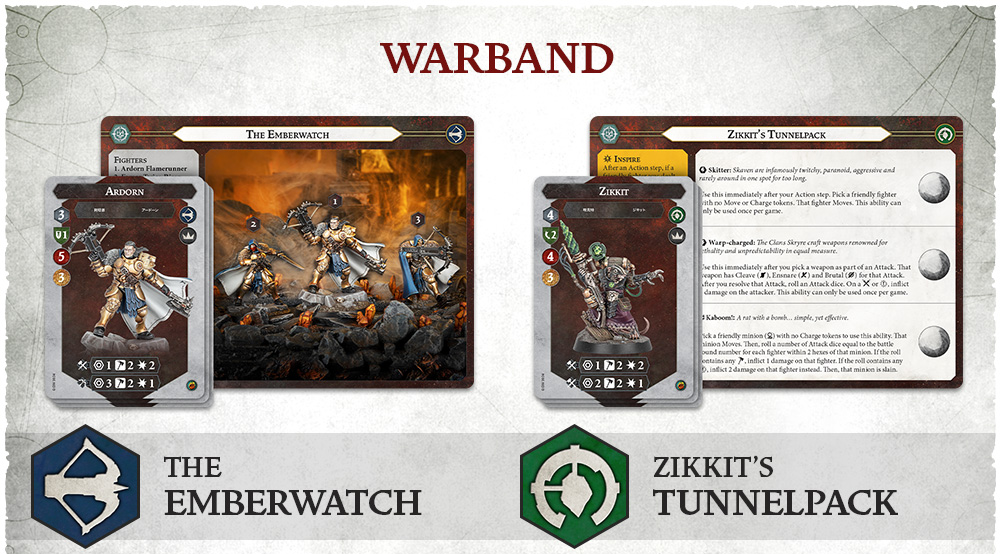
The fighter cards and their accompanying warscroll have been featured heavily in the Warhammer Community previews, so if you’ve been following any of that you’re not in for a huge surprise. If you haven’t… surprise! Fighter cards have been modified greatly from their previous iterations. They’ve been streamlined and now feature only the fighter stats and name – gone are inspiration mechanics, special actions, and other rules specific to the fighters. The majority of the card is now taken up with a large image of the fighter’s model, making it abundantly clear which card corresponds with which of your models on the tabletop. The previous stats are all there (name, move, save, health, weapons) along with the new bounty characteristic. Each fighter has their own distinct bounty characteristic. This is the amount of glory your opponent will gain when your fighter is slain. A nice change here is that each warband will offer up a total of 7 glory in bounty – previously, the lower model count elite warbands had a massive advantage in that not only were their fighters traditionally more difficult to slay than a weaker horde, but they also offered a piddling reward for doing so. Now the rewards roughly correspond with the effort required, which is one way in which horde warbands have been nudged into being a more competitive pick.
Runemarks are also a “new” aspect of the game called out by name in the rulebook. These existed previously, but were referred to as icons in the last edition’s rulebook. Now they have a little more rules weight in addition to being shorthand, visual ways to categorize fighters. Sometimes these runemarks have extra rules associated with them (e.g. the flying runemark grants more flexibility in movement) but others are simply indicators that will match up with cards that require the runemark to be present (e.g. the minion runemark). Tik Tik from the Zikkit’s Tunnelpack warband has the spiked collar runemark that signifies they’re a minion, and the Tunnelpack’s warscroll has an ability that is only usable by minions.
Runemarks not only apply to fighters, but also to their weapons. These are referred to as weapon abilities in the rulebook, and a very important rule regarding them is that if a weapon has more than one runemark, a player must choose which one they want to use – there are ways to gain multiple runemarks on a weapon (stacking cleave, grievous, stagger, etc.) but you will have to choose which one will be active before making your attack roll. I feel like this will be one of the most common rules mistakes players make while coming to grips with the new edition. It also has very large ramifications for stacking upgrades and buffs onto a single fighter. Previously, there wasn’t anything stopping you from putting multiple +1 damage upgrades onto a fighter and turning them into a juggernaut of destruction. You still can put grievous onto a fighter multiple times, but since you can only pick one instance of grievous, the extras are all going to be wasted. It’s a clever way to still include the powerful damage increasing cards without letting them spiral out of control.
I don’t think the weapon range indicators are technically runemarks, but they function in the same way. Weapons that have a range of 1 or 2 are classified as melee weapons, and weapons that have a range characteristic of 3 or higher are considered ranged weapons. It’s another way of short handing terminology that gets referenced on multiple cards. It means a card that would read “+1 damage to this fighter’s range 1 and range 2 attack actions” can now be simplified to “This fighter’s melee weapons have grievous” which both takes up less space on a card and is closer to being a sentence someone would actually say.
Pick a Card, Any Card
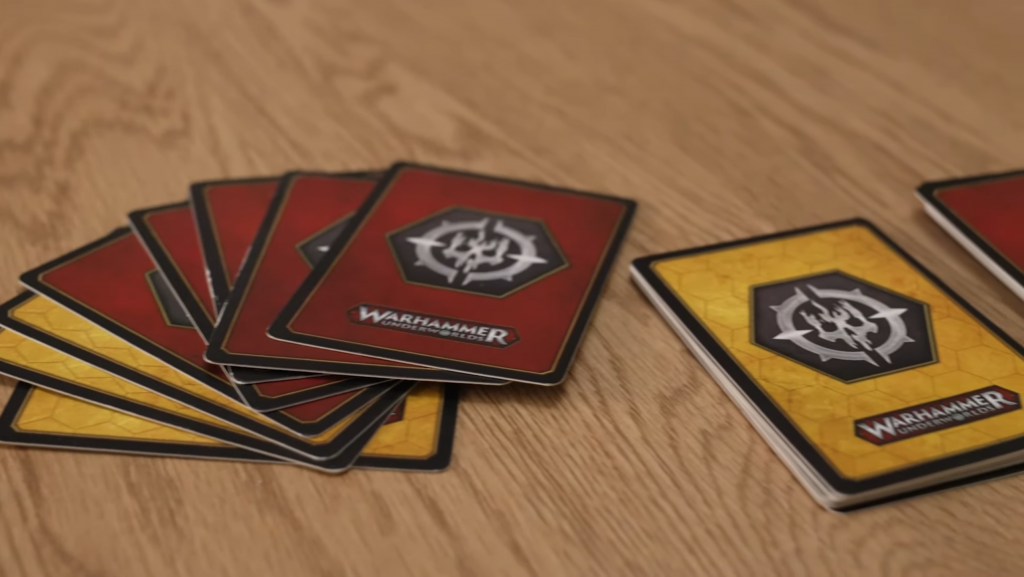
The last of the three big changes is the lack of any warband specific decks. Those have been retired, and instead the universal Rivals decks will take their place. These still each consist of a 12 card objective deck and a 20 card power deck. Games Workshop has helpfully categorized each of the decks in Embergard, and any following decks, with one of four broad playstyle names. Strike, Take and Hold, Flex, and Mastery roughly describe what the decks will naturally tend toward supporting in terms of game plans. The warbands themselves also have one of these playstyle names, so while there isn’t a bespoke deck for each warband, a player can still easily match up their warband with a complementary deck. That said, any warband can take any Rivals deck, so there is no inherent requirement that your Strike warband takes a Strike deck.
This is probably the best place to touch on the two officially supported formats in the new edition as well. Rivals makes a return, but with the expected tweak since there are no warband decks. You can pick any warband, any Rivals deck, and go. This is the grab-and-go format of choice if you want to go from opening a box to playing as soon as possible. It’s also a less daunting place to start if you’re coming from other tabletop games that don’t do deck building. It will probably be an even smoother on ramp than it was previously given these decks tend to be more focused and have fewer dud cards than decks in the last edition.
The other format is Nemesis, which is very similar to Rivals with one small change. You take two Rivals decks instead of one, combine their cards into a single pool, and then build a deck out of that pool. That means you’ll be picking 12 objective cards out of the possible 24, and 20 power cards out of the possible 40. Again, there is no restriction on matching your archetypes so if you want to run a Strike warband with a combined Mastery and Flex decks, you’re more than welcome to.
As for changes to the physical cards, there are a few. The layout has been shifted around a bit, and the most prominent change is the decision to swap from illustrations to photographs. Initially, I was not a fan of this change. Spending more time with the cards and seeing that the photography is well staged, dramatically lit, and in some cases highly creative has brought me around to appreciating it. I’ll still miss some of the more characterful illustrations of the past, but this change helps unify the look of the cards while showcasing one of the biggest strengths Games Workshop has always had – highly detailed and impressive models.
If this brief overview of card discussion wasn’t enough for you, you’re in luck. Check out the coverage of the four Rivals decks in their own dedicated articles. You can find them here: Blazing Assault and Emberstone Sentinels and Pillage & Plunder and Countdown to Cataclysm.
The Various and Sundry
There are also some smaller, less obvious things in the box. For instance, the damage and glory point tokens are double sided with different values on each side. The raise and generic counters are now opposing faces on the same piece of cardboard. Power cards now sport a red coloration instead of blue – this one’s kind of baffling to me, but whatever. It just gives me another excuse to not reuse my old blue card sleeves. Compared to previous core boxes, there also are no magic dice in the box or even mentioned in the rules. If you were particularly fond of any of the older faction or grand alliance dice, this last bit is actually good news because they didn’t come with magic dice! Dig them out and get to rolling.
Oh yeah, there’s also a rulebook in here that has new rules in it. Let’s look at that.
The Rules
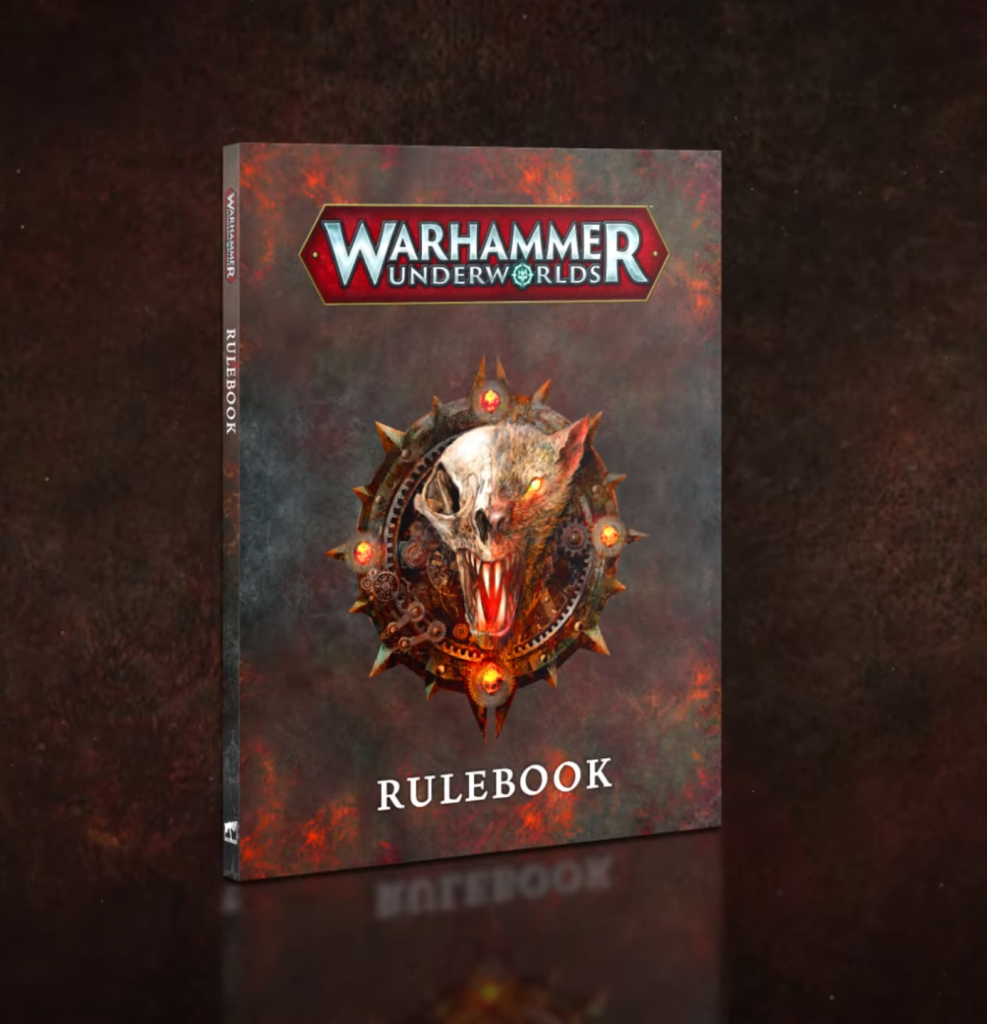
The core of the game remains the same as it was before, which is wonderful news. I think Underworlds is a prime example of a system that has “good bones” but needed the equivalent of some cosmetic work. The game still is primarily about managing your hard limit of 12 turns while trying to score the most glory.
Setting Up
The “turn 0” process of setting up the game has been significantly streamlined, in part due to the new board. This is one of my personal highlights in Embergard because I felt that, especially in teaching games, you had two options when setting up the boards and treasure tokens. You could either walk the other player through the process, which is an opaque experience where they know their choices have to matter but not why, and it’s hard to get into that before even playing your first game. It also served as a speed bump in building any enthusiasm about playing the game because you had this busy work to do before getting to the fun bits. The other option, which I defaulted to after some trial and error, was to just skip the setup portion entirely and use a basic board and treasure layout for both players to get right into the game. Given that, it’s not hard to see why I’m pretty excited that Games Workshop stole my idea implemented a similar approach.
When you sit down to play Underworlds with Embergard, here’s the new process:

Muster warbands is simply getting the board game elements out and on the table. You and your opponent both stage your warscrolls, fighter cards, miniatures, and decks along with 4 turn tokens.
Next up is drawing your starting hand. Each player shuffles their objective deck and draws 3 cards from it, as well as shuffling their power deck and drawing 5 cards from it. This is also the stage where players decide if they want to redraw their starting hands. In Embergard, a redraw has a player place all of their objective cards and/or all of their power cards aside face down, draw replacements from their deck, then shuffle the set aside cards back into their respective decks. An interesting change is that the cards you’re shuffling away are not revealed and remain hidden information, unlike in the previous edition.
After both players have decided whether or not to redraw, the first roll-off of the game occurs. The winner determines both which facing of the game board will be up as well as the orientation of the game board.
The player who did not win the previous roll off then places the first treasure token face down in neutral territory. Treasure token placement alternates between players, but they still cannot be placed in edge hexes, starting hexes, blocked hexes, stagger hexes, or within 2 of another feature token. There must also always be at least 1 feature token in each player’s territory, so if by the 5th placement there isn’t one somewhere, that’s where the last one has to go. The stipulation of allowing a feature token to be placed in an edge hex if it’s otherwise impossible to place is still there.
Finally, fighters get deployed on the board. The player who placed the final feature token (which will also be the player who lost the earlier roll-off) must place a fighter first. This alternates between players until all the fighters are deployed.
That’s it. A quicker pre-game stage where players can get into the meat of the game.
The Three Battle Rounds
The majority of a game’s time is spent in the three battle rounds, and if you have any familiarity with the previous edition of the game you’ll notice there hasn’t been many changes here. One of the most significant ones occurs at the very first portion of every battle round, though. As before, each round starts with the players performing a roll-off to determine who will take the first turn. The change here is that the player who loses the roll-off draws 1 power card regardless of who the roll-off winner selects to take the first turn. Of note, this rule does not say one player gets the first turn and the other draws a power card – the bonus power card is solely determined by the result of the roll-off. Additionally, any ties here in the 2nd and 3rd battle rounds are won by the player who is the underdog.
“The what?” you may ask. Underdog is a mechanic introduced in this edition of Warhammer Underworlds that was most recently seen in the Spearhead version of Age of Sigmar. A player is the underdog if they have fewer glory points than their opponent. That’s it. Aside from winning ties on roll-offs, it doesn’t do anything itself, but some cards will have enhanced effects if played by the underdog player.
Combat Phase
The combat phase is where the players alternate taking turns. There’s nothing particularly different here, so if you’ve played previous you’re good to go. Each turn continues to be broken into an action step and a power step; the action step is where the active player picks a core ability to use. There are universal ones in the rules including move, attack, charge, guard, and the new option with focus (which is really just the old venture plus strategize options dialed up to 11), but other cards like upgrades can introduce new core abilities. They’ll be identified by the Underworlds skull icon, so keep your eyes peeled. After the active player performs a core ability, the action step is over and the power step begins. Starting with the active player, players alternate either playing a power card, using a warscroll ability, using the delve ability, or passing. Once both players pass, the turn moves to the next player and the cycle repeats. There are 4 turns per player in each battle round.
After the final power step of the final turn in the battle round, it’s time for the creatively named end phase.
End Phase
Unless we have missed something, there is no difference in how the end phase is handled now compared to how it was previously. The player who took the first turn in the battle round still starts here and performs the following five (basically four) steps, then the other player does the same.
First up is scoring your objectives. After you’ve scored as many objectives as you are able to, you get a chance to use that freshly acquired glory to play upgrades. If you have anything sitting in your hand that you’d rather get rid of and free up space, this is where you do it. Because the final two steps are drawing objective cards until you have 3, then drawing power cards until you have 5.
After that, the move/charge/guard/stagger tokens on the board are cleared and you move on to the next battle round. If this was the third battle round, the game ends and whoever has the most glory is the winner!
Other Changes
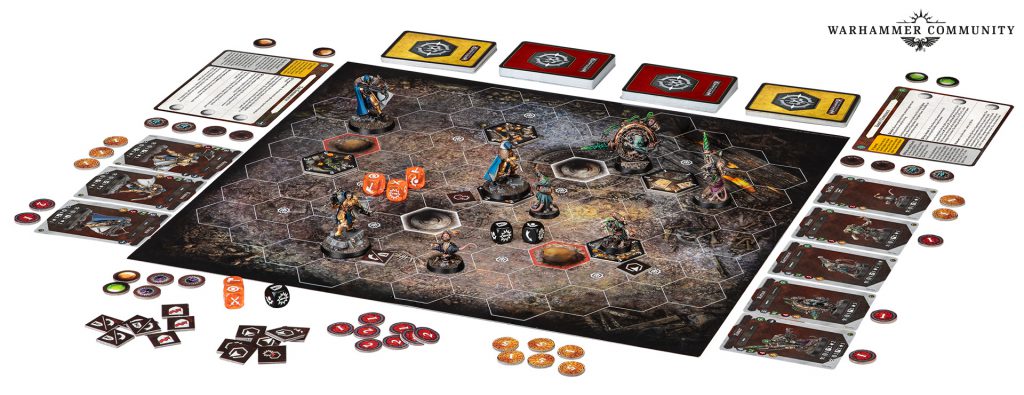
Here’s a bit of a grab bag of other things I have noticed.
The mechanic of the roll-off has been shifted a bit. Instead of both players rolling 4 dice, each player is only going to roll a single attack dice. There’s a hierarchy of results to determine who wins. A critical attack result is the best, followed by swords, then hammer, then surrounded, then flanked. The ordering feels a little arbitrary to me, so if anyone notices a pattern here I’d love to know what it is.
Flying has received a very slight reduction in power compared to last edition. Now, it doesn’t permit moving through blocked hexes. Flying fighters still move through occupied hexes and aren’t affected by stagger hexes when using the move ability.
The red bordered hexes you see on the board are stagger hexes, not lethal hexes.
One set of changes that will either be negligible or strategy defining based on the warbands being played is how the raise mechanic works. When a fighter is raised, they are placed back on the board but their bounty characteristic becomes zero! No more endlessly farming the easily killed skeletal petitioners, electric zombies, or dinky Skaven. This helps to offset some other changes, notably how when a fighter is slain all their upgrades are discarded and they are uninspired.
Fighters can also have a stagger token and guard token at the same time; these no longer replace each other. For the decks or warbands that gain extra bonuses from stagger, it’s a lot harder to deny them by taking the guard action.
Speaking of stagger tokens and limitations, delve no longer requires the delving fighter to not be staggered. There’s still a limit to only using delve once in each power step, but it’s theoretically possible for the same fighter to do it all four turns.
The change to how critical results on dice function is also a major change. The short version is that critical results are just treated as a success, like any other result that would be a success. For instance, if you have an attack that’s 3 hammers and roll results of critical, hammer, and sword then you have two successes. There’s no more “one critical result beats any number of non-critical results.” What a critical roll on an attack or save does do is grant the use of overrun or stand fast. Overrun is used when the attacker has more critical results than the defender and simply lets the attacking fighter be pushed 1 hex into the hex the target was in. This would be used when driving back or slaying your target. Stand fast is an option for the defender if they rolled more critical results than the attacker. In this case, the attacker’s weapon suffers -1 damage and the target cannot be driven back. Critical results on dice rolls will still have an impact, and it can still be game deciding, but they’re going to be less swingy on average.
All the reaction windows have been scrapped and instead, cards will have a surge symbol on them to not when you can play it in response to something happening in the game. Surge symbols are the lightning bolt in a hexagon that were previously used for denoting reaction windows, so this is an intuitive change for returning players. You’ll see this on either side of the name for some objectives (which makes them surge objectives) and some ploys (making them, unsurprisingly, surge ploys). Upgrades can also have this icon in their text when they’re granting their upgraded fighter a surge ability.
Along with ensnare and cleave, there’s a new dice ignoring runemark called brutal. This negates results of flanked or surrounded from counting as successes. Additionally, there’s a grapple runemark that allows an attacker to push the target 1 hex instead of driving them back.
Some weapons will simply have a runemark that you can use. Other weapons can have the same runemarks preceded by a critical symbol. In the latter case, the weapon ability is only active if the attack roll contains one or more critical results.
Wrap Up and a Few Questions
The rules are quite short this time around. Clocking in at 16 pages of rules text, plus a few extra describing the Nemesis format and short primers for each of the warbands and decks in Embergard, it’s not going to take long for players to go from cracking open the box to getting their first games in.
That said, I did wind up with a couple of questions after working through the rules that I feel GW may want to address in an FAQ or similar document.
1) In the muster warbands step of set up, the rulebook says players “reveal their choice” which is a little ambiguous – obviously, you’re going to reveal your warband but do you have to reveal the specific Rivals deck(s) that were chosen as well? In the past, this was a minor downside to using decks with plot cards. You’d have to reveal the plot card, giving your opponent some information about your deck. If your decks didn’t have plot cards, you retained that tiny bit of information until the game was underway and you were playing your first cards. Frankly, I’d love the reveal requirement to also include your Rival(s) decks – sometimes I feel people play up the value of hidden information too much in Underworlds and it leads to behaviors like finishing your games as fast as you can to scout your potential future opponents or being an unpleasant and cagey person to talk to before and during the event.
2) For redrawing a starting hand, is there an order as to who has to choose first? There have been no roll-offs at this stage, so it cannot fall back on that to decide. I don’t feel like this one is nearly as important, and to be completely honest I always forgot who was supposed to declare redraws first in the prior edition of the game and it never once mattered. The edge cases where getting information from seeing what your opponent is throwing back before making your decision has been removed, so it’s even less consequential than it was before. I’m sure there’s some edge case where it could have an impact, but it escapes me for now.
Neither of those concerns are particularly troubling for me right now. I imagine the first will be addressed very quickly, and the latter is more just me being curious.
That’s it for the box and rules review! We also have reviews covering the Rivals decks and two warbands included in Embergard, along with more upcoming coverage of the new edition as time goes on.
Have any questions or feedback? Drop us a note in the comments below or email us at contact@goonhammer.com. Want articles like this linked in your inbox every Monday morning? Sign up for our newsletter. And don’t forget that you can support us on Patreon for backer rewards like early video content, Administratum access, an ad-free experience on our website and more.
